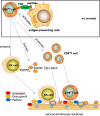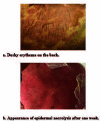Chemotherapy-induced toxic epidermal necrolysis in a patient with multiple myeloma, a case report and literature review
- PMID: 37601673
- PMCID: PMC10433741
- DOI: 10.3389/fonc.2023.1227448
Chemotherapy-induced toxic epidermal necrolysis in a patient with multiple myeloma, a case report and literature review
Abstract
Rationale and patient concerns: Toxic epidermal necrolysis (TEN) and Stevens-Johnson syndrome (SJS) are severe drug-induced skin reactions associated with a high mortality rate. The patient in this case report developed TEN after receiving the Velcade-lenalidomide-dexamethasone (VRD) regimen for the treatment of multiple myeloma (MM). The patient's concerns included the progression of the rash, pain, itching, and potential long-term complications. TEN is a life-threatening condition that requires prompt medical intervention and hospitalization.
Interventions: The treatment approach for the patient included discontinuation of the causative medication (lenalidomide) and comprehensive supportive therapy. Supportive measures included the administration of systemic corticosteroids (methylprednisolone), intravenous immunoglobulin infusion, pain relief medication (ebastine), antibiotic prophylaxis, laminar bed use, and regular dressing changes. The goal was to alleviate symptoms, promote skin and mucous membrane healing, and prevent complications such as infection.
Diagnosis: The patient was diagnosed with stage III A DS and stage III ISS MM, specifically of the immunoglobulin G (λ) type. Diagnostic procedures included CT and MRI scans, bone marrow testing through flow cytometry and morphology analysis, and laboratory tests to assess blood markers. The diagnosis of TEN was made based on the clinical presentation, skin biopsy, and exclusion of other potential causes.
Outcomes: With the implemented interventions, the patient's condition gradually improved, and the rash resolved without any residual scarring. The patient's skin and mucosa healed, blood markers improved, and bone pain was relieved. The patient was discharged within a month of receiving the final treatment with bortezomib and dexamethasone. The patient got partial response(PR) of multiple myeloma.
Lessons: Drug-induced SJS/TEN is more prevalent in Asian populations, potentially due to differences in human leukocyte antigen (HLA) alleles. The use of systemic corticosteroid therapy in SJS/TEN cases is controversial due to the potential risks of immune suppression and complications. Balancing the immune response to prevent SJS/TEN while maintaining an effective cytotoxic immune response for tumor control remains a challenge. Lenalidomide, an immunomodulatory agent, can enhance antitumor immune responses but also contribute to the pathogenesis of SJS/TEN. Increased awareness of HLA variations and frequently mutated genes in different malignancies can help prevent SJS/TEN and improve patient outcomes.
Keywords: Stevens–Johnson syndrome; adverse drug reaction; lenalidomide; multiple myeloma; toxic epidermal necrolysis; tumor microenvironment.
Copyright © 2023 X, W, W, Z, W, C and W.
Conflict of interest statement
The authors declare that the research was conducted in the absence of any commercial or financial relationships that could be construed as a potential conflict of interest.
Figures



References
-
- Creamer D, Walsh SA, Dziewulski P, Exton LS, Lee HY, Dart JKG, et al. . UK guidelines for the management of Stevens-Johnson Syndrome/Toxic Epidermal Necrolysis in adults 2016 (print summary – Full guidelines available at http://dx.doi.org/10.1016/j.bjps.2016.01.034). J Plastic Reconstructive Aesthetic Surg (2016) 69:736–41. doi: 10.1016/j.bjps.2016.04.018 - DOI - PubMed
Publication types
LinkOut - more resources
Full Text Sources
Research Materials

